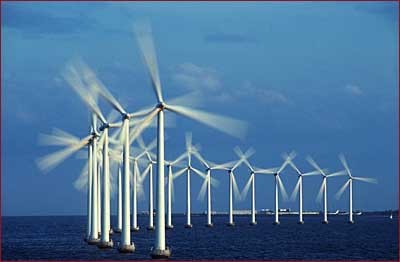The debate on the energy transition is on its way in France, as in most developed countries, but do we have a clear vision about what a transition is representing? Generally speaking, a transition is occurring when by a slow or abrupt change that takes place during a period where a “system” subject to severe constraints suffers ruptures by which it can be destabilized until it recovers a new equilibrium state. As far as energy is concerned, this system would consist in all energy sectors of an era, for example in the XVIII th century where wood, hydraulics, wind (windmills) were very strong in the energy mix while coal began slowly its rise. Thus, with their own lorgnette historians would certainly reveal that humanity has constantly sought to diversify its energy resources : during Antiquity, the wood, animal muscular energy and the slave labor force were the only energy resources, while during the Middle-Ages, hydraulics and windmills, innovations imported from the Middle-East, with firewood completed the energy mix and then coal gradually took over during the XVIII th and XIX th centuries. Energy historians have often shown (see for example, the recent book by C. Bonneuil and J – B. Fressoz « L’événement anthropocene », Le Seuil, Paris, 2013) that if the planet has already experienced energy transitions, she has not truly confronted with « An » energy transition because the introduction of a new energy option has always taken time. Thus the steam engine, a true technical paradigm shift since, for the first time, work was produced from heat, caused a technical and industrial revolution which was spread out on almost a century. In other words, the energy transition we are talking about assumes the cohabitation, for probably several decades, of both new and old energy systems, e.g. solar panels, wind farms and gas turbines, with the advent of scientific and technical successes and failures, the evolution of our lifestyles and working, new modes of governance of our institutions, new cooperation modes between nations. On each of these points, one should clearly explain what kind of actions is needed to make things happen. We shall be aware also that this transition will not evolve as a long and quiet river. It may be recalled in this regard that during XVIII e century, massive deforestation in some European countries, as England where the wood for domestic heating and metallurgy needs were growing, had gradually led to an energy crisis. Humanities and social sciences can certainly help us to better understand the profound significance of the energy transition through research programmes as those that are presented in a very interesting note by the French organization Athena (the Alliance of organizations for research in Humanities and social sciences, www.allianceathena.fr , “SHS et energie”).
Thus the steam engine, a true technical paradigm shift since, for the first time, work was produced from heat, caused a technical and industrial revolution which was spread out on almost a century. In other words, the energy transition we are talking about assumes the cohabitation, for probably several decades, of both new and old energy systems, e.g. solar panels, wind farms and gas turbines, with the advent of scientific and technical successes and failures, the evolution of our lifestyles and working, new modes of governance of our institutions, new cooperation modes between nations. On each of these points, one should clearly explain what kind of actions is needed to make things happen. We shall be aware also that this transition will not evolve as a long and quiet river. It may be recalled in this regard that during XVIII e century, massive deforestation in some European countries, as England where the wood for domestic heating and metallurgy needs were growing, had gradually led to an energy crisis. Humanities and social sciences can certainly help us to better understand the profound significance of the energy transition through research programmes as those that are presented in a very interesting note by the French organization Athena (the Alliance of organizations for research in Humanities and social sciences, www.allianceathena.fr , “SHS et energie”).
Are there “critical” points for an energy transition whose objectives would be decreasing energy consumption in all sectors and diminishing the weight of carbon energy? In its World Energy Outlook 2013, the IEA (www.worldenergyoulook.org ) devotes an entire chapter to the energy intensity because it should be considered as an « essential component of a sustainable energy future”. This intensity is, let us remember, the amount of energy that must be spend to produce a unit of GDP. The IEA noted that it fell by 1.5% in 2012 while the annual average decline was only 0.4% between 2000 and 2010. China seems to be undertaking a major effort since while its energy intensity was four times the world average in 1990 it represented “only” a little more than the double in 2012. Of course, the decline of a country energy intensity is the result of a set of national and regional policies and is therefore an indicator on the path of a transition and it does not preclude the coexistence of a large variety of options. In its ‘new policies’ scenario that integrates all policies adopted recently in order to reduce the energy demand (but which cannot limit the warming to 2 ° C), IEA « expects » that the industry and building sectors will contribute the most to the improvement of energy efficiency (37% and 26% of the total effort by 2035).
The recent Warsaw conference on the climate has revealed that there remain a lot of obstacles on the way to the signing of a climate treaty in Paris, in 2015, which are still considerable. They are mostly political because the signatories must agree on a mechanism for fixing quotas of (especially CO2) greenhouse gas emissions in order to limit to 2 ° C the increase in the average temperature of the planet (the target adopted in Copenhagen), but they are also technical because combating global warming requires progress in energy efficiency and the use of non-carbon energy. Could R & D facilitate this transition and constitute a key element of the negotiation? It is this question that has sought to answer a team of climate specialists working with the Italian Foundation Enrico Mattei (created by ENI) in a recent note (G.Marangoni and M. Tavoni, The clean energy R & D for 2 ° C, 2013, Fondazione Eni Enrico Mattei, www.feem.it ). Using a model strangely called WITCH (World Induced Technical Change Hybrid Model) and seven climate and energy scenarios, they believe that financial investments in R & D (necessary to remove technical barriers to the energy transition) would amount to 1 trillion dollars over the period 2010-2030 and 1600 billion of 2030-2050. It is now far from the account because the gap between expenditures for R & D of developed countries in this field and their calculated goal would be in the range of 30 to 58 billion dollars a year. Requested effort would represent a little less than 0.1% of world GDP an (annual average), but would be undertaken initially by developed countries. Can we achieve Copenhagen climate objective only through a strong amplification of the R & D and innovation strategy? Authors of the note do believe that it would be unrealistic and that it would not overcome a limitation of CO2 emissions effort conducted in parallel. However, if climate negotiations were at an impasse, they envisage a scenario where at first (until 2030), the most developed countries would commit themselves to strongly increase their efforts in energy research and innovation with a policy of technology transfer to the developing countries so that they would lower their energy intensity and use less carbon energies, to load for them to take over from the R & D after 2030 while reducing strongly their greenhouse gas emissions. This option assumes that scientific and technical cooperation between partners from different regions of the planet would constitute by 2030 a real climate deal.
R & D is probably not the key to the energy transition but it is an important parameter, rarely taken into account, as it can contribute to alleviate obstacles blocking the transition road, as the front of the climate negotiations is moving.
